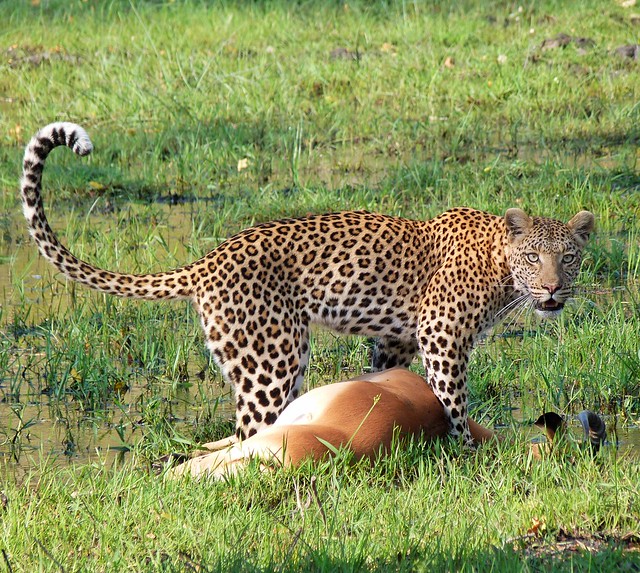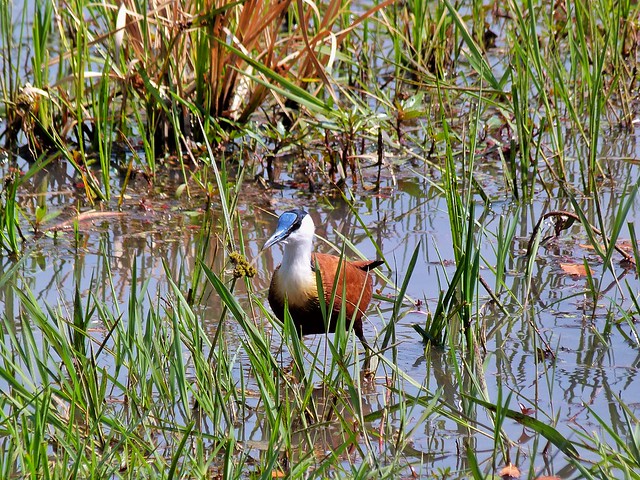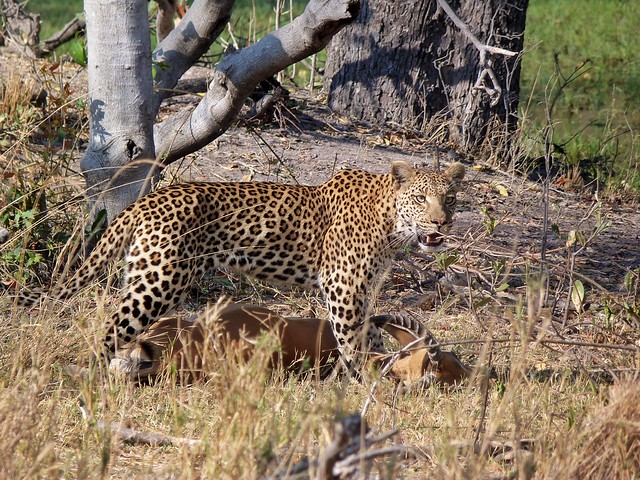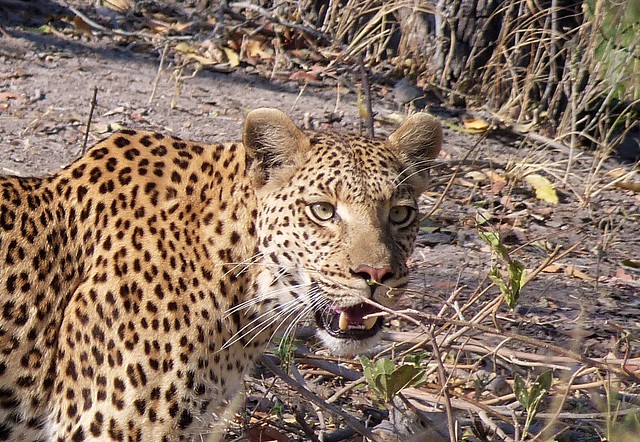
It is a sad fact that man man has become the leopards worse enemy, hunting for fun or to sell their prized fur. It's this coat that perfectly camouflages the leopard, letting it hide and go unnoticed within the African savannah, or thick jungles, or even snows of Siberia. It is perhaps for this reason, that the probability of seeing a leopard in the wild is much lower than encountering a pride of lions (or more). But this elusiveness just made the possibility of encountering a leopard in Botswana all the sweeter for me, and I knew one of the highlights of a safari would be to look eyeball to eyeball with this majestic animal.

Leopard photographed in the Kruger Park last time SudáfricaLa could photograph the leopard before returning to Botswana held in Sabi Sands Reserve in South Africa, within the famous Kruger Park.
The big Leopard Moremi
After a couple of days in Moremi where we had seen enough lions, zebras, giraffes and elephants, we were excited to go out and find the leopard. I was part of the group belonging to this mobile safari in Botswana who had never witnessed a leopard, so there was a sense of nervous excitement among us all. Although the previous year in Botswana there had been no sightings, a few years prior, I had been fortunate enough to observe and photograph a leopard, in the Kruger Park, South Africa and Sri Lanka Yala Park. In fact, in my living room chairs a photograph in a tree of my first encounter with this predator.
But once in Moremi, on my return to one of the most beautiful reserves in the African continent, I took this trace as if I had never seen a leopard before.
Leopard photographed on my first trip to BotswanaImagen the first leopard I saw in my life (Location: Near Mababe Gate, between Moremi and Chobe, Botswana). Read full story in the story called Night of hyenas.
Across track planes Xakanaxa arises what is known as Paradise Island, a portion of land irrigated by immense wetlands where in addition to the cranes, jabiru storks, ospreys Jacanas that come to drink at various watering holes, are not to far off are antelope, lechwe and waterbucks. In short, a good place where a wandering Leopard would find a good meal.

Paradise Island (Moremi, Botswana)
Footprints leopard populate the path
After a dawn worthy of framing, the expedition team ended up in Paradise Island. The greatest chance to track a animal comes at early morning. Leopards and other predators like to travel long distances and use the sands as roads. Just this morning, we found the fresh tracks of a leopard female who was with her baby and a lone male. They were so fresh that it could have only been have happened minutes earlier. Two hours maximum.
The fresh print of a leopard
Starting from scratch we had several points in our favor to try to succeed in the Moremi morning safari. The area we were in was leopard territory, our guide Willie had spotted sightings of several leopard footprints and there were also traces that proved it had traveled the road between night and sunrise. But sometimes, even sightings of footprints are not enough. You could have a hundred leopards in in the trees, tall dry grasses and shrubs and they could easily pass unnoticed. Northern Botswana, compared with Kenya or Tanzania, is quite lush and it takes more than luck to meet certain fauna. But that gives you a very interesting motivational factor.
Tracking footprints Mopane guides in Moremi Game Safaris (Botswana)
Willie began broadcasting his obsession to the group that was in the SUV. He got out of the car, analyzing the trajectories of the tracks and came to show the outline of its tail in the sand. According to him, after drinking water she had been sitting for a while. The mark was there and that made him more sure he would find.

The footprints that had not yet been disfigured by the shot of any vehicle took us to a termite mound. And there they disappeared. It seemed that the leopard had been in the water almost completely and wet, then stay in the back of this kind of mud created by fire ants and that is so characteristic of sub-Saharan Africa. According Willie had been due to be watching from there to their possible prey. And that is about 100 meters one lechwes numbers (his favorite) group and impalas, grazing peacefully with legs slightly submerged in the water of the wetland. One possibility is that had gone for one of them. And again, holding the base of insight our seasoned driver, is that he was tending a trap ... at that moment.
Jacana in a wetland (Botswana)
We were all hooked on this search as ever. At that time there was nothing and no one to care about us more than meet the leopard. And we were developing the story with tracking seemed the script for a thriller. On the one hand we knew the difficulty of the enterprise. But then something told us that we would end up experiencing one of the momentazos trip.

To rule out possibilities the decision was made to circle the map of the area. Besides the other car, whose team was led by Costa, a Bushman who knew all the ways of the leopard, and was in constant radio contact with Willie. Between the two SUVs we were thirteen people in total, and twenty six eyes. Added to this guides that would be able to spot a animal in most camflouged situations.
The footprints that had not yet been disfigured by the shot of any vehicle took us to a termite mound. And there they disappeared. It seemed that the leopard had been in the water almost completely and wet, then stay in the back of this kind of mud created by fire ants and which is so characteristic of sub-Saharan Africa. According to Willie, it had been watching from there for their possible prey. And that is was about 100 meters from a group of lechwes (his favorite animal) and impalas, grazing peacefully with legs slightly submerged in the water of the wetland. One possibility is that had gone for one of them. And again, holding the base of insight our seasoned driver, is that he was tending a trap ... at that moment.

Jacana in a wetland (Botswana)
We were all hooked on this search as ever. At that time there was nothing and no one to care about us more than meet the leopard. And we were developing the story with tracking seemed the script for a thriller. On the one hand we knew the difficulty of the enterprise. But then something told us that we would end up experiencing one of the momentazos trip.

Intensive Tracking the 4 × 4
To rule out possibilities the decision was made to go in circles on the map of the area. Were even thicker dimensions that we track, but could be used to refine your search a little more. Besides the other car Mopane, whose team led Costa, a Bushman also knew that all was always in radio contact with Willie. Between the two SUVs we were thirteen people in total, twenty eyes. While I assure you of our guides were worth percent. They were able to see where other animals would have seen a stone ...
Mopane SUV Game Safaris in Botswana
We walked the trails.The land was full of obstacles between holes, areas of water and had to wade through the lot of dead branches or fallen trees that we should overcome. We were able to access various points from which the great pond antelopes observed. There appeared to be alert and tense, as often we found the impala, members of a species that are the often the fast food for predators. They remained calm, although they were probably unaware that a leopard hunting with speed, agility and patience, was watching from somewhere nearby.
Ring the alarm!
Then something changed in our drivers face. There was an excessive noise when minutes before there was absolute silence. The birds were making a racket in the branches of a trees. They seemed altered and somewhat hysterical as their cries sounded across the Savanagh. Willie had no doubt something had occured. Nothing more and nothing less than nature sounding its' alarm.
Toco gentoo (Photographed in Botswana)
Some species, though not absolutely have to do with each other, throwing warning sounds when they are against a possible enemy. And they warn each other as a gesture of camaraderie. It would not be strange that all those birds knew that the leopard was nearby and were alerting other animals. But it wasn't just the birds behaviour that had changed. Squirrels seemed more nervous than usual and made sounds, the monkeys had suddenly risen to the top of the trees and groups of impala and lechwe were put in alert position.
Lechwe in Moremi (Botswana)
The two binoculars in our car had set to work. Inched seek some sign to know if spontaneous messages of nature, the weakest animals alerting potential prey of the predator, they were right. Suddenly David, a member of our team, shouted " there it is!". All head turned to where he pointed, the area of shrubs and tall grass where he claimed to have seen the mottled back.

David leopard looking with binoculars in Botswana
We approached quickly to the designated area and this time was Reyes who, also with the aid of binoculars, perfectly saw our beautiful friends fur. Just then the animal got deeper into the thick shrubbery, and we lost sight of him once more.

Dwindling hopes of seeing him again
The sun began to rise more and the time then began to play against us. In the heat, the leopard probably immediately saught shade to ease the rigors of the thermometer. And in which case it would not move from that position for hours. Without movement, the chances of spotting the animal is severely reduced. And with them, our hopes.
Leopard! Leopard!
We stopped to do some photographs of a nearby group of impalas. In the morning there was still much to continue enjoying in that breath taking habitat that is the Moremi Game Reserve, a favorite of travelers who visit places Botswana. So all of us got busy with cameras and simply watching the splendor in front of us.
But suddenly Willies voice, usually rather soft and thin, sounded like a roar. He got nervous and started to point to our right. And out of his mouth he could only leave a word in English: LEOPARD!
Indeed, this was a leopard walking through dry grass. And she is wearing something with it. After a few seconds of doubt we realized that dragging a dead impala. We watched on, our hearts racing, wanting to see more, and yet wanting to keep our distance. It is at these times you truly understand how powerful these creatures really are.

Leopard on Moremi (Botswana)
The cat set his eyes on us. He... looked exhausted. It was normal, since hunting takes up a great deal of energy and that impala probably gave him a good run for his money. While panting, he looked for a place to disappear right away and hide with his prey before other predators and scavengers, especially hyenas, snatched the trophy he had worked so hard to achieve.

Leopard on Moremi (Botswana)
He went his way and slowly we followed it to a wetland used as a shortcut to continue dragging the impala. I'll never forget the last time I looked its eyes. I left seriously hypnotized. That figure was spotted giving us unwittingly one of the most extraordinary moments of our safari in Botswana. And so he hid the piece. Typically, they climb a tree to eat it later without danger of being disturbed. The hunted impala male was a large male, and would probably (without the disturbance) would feed the leopard for three days until nothing is left but a ghostly skeleton at the mercy of the vultures.

I leopard dragging Impala in Moremi (Botswana)
What happened that day was the realization that contemplate the beauty of a wild animal in freedom it is comparable to little or nothing. And that we had missed only one issue to be addressed in the lecture undertaken tracking hours ago: Patience. When you go on safari there will never surrender. In Africa and anywhere in the world under the dictates of nature, things can happen suddenly, when you least expect it. That is why a good deal of stamina is needed, and with that you can turn an ordinary safari into the best trip of your whole life.

No comments:
Post a Comment